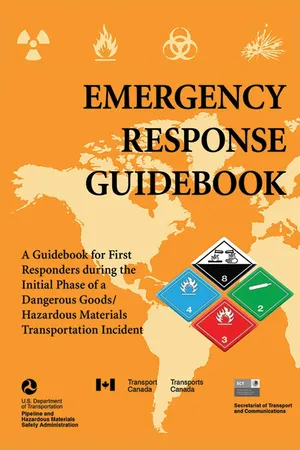
Emergency Response Guidebook
A Guidebook for First Responders during the Initial Phase of a Dangerous Goods/Hazardous Materials Transportation Incident
- 400 pages
- English
- ePUB (mobile friendly)
- Available on iOS & Android
Emergency Response Guidebook
A Guidebook for First Responders during the Initial Phase of a Dangerous Goods/Hazardous Materials Transportation Incident
About This Book
Does the identification number 60 indicate a toxic substance or a flammable solid, in the molten state at an elevated temperature? Does the identification number 1035 indicate ethane or butane? What is the difference between natural gas transmission pipelines and natural gas distribution pipelines? If you came upon an overturned truck on the highway that was leaking, would you be able to identify if it was hazardous and know what steps to take?
Questions like these and more are answered in the Emergency Response Guidebook. Learn how to identify symbols for and vehicles carrying toxic, flammable, explosive, radioactive, or otherwise harmful substances and how to respond once an incident involving those substances has been identified. Always be prepared in situations that are unfamiliar and dangerous and know how to rectify them. Keeping this guide around at all times will ensure that, if you were to come upon a transportation situation involving hazardous substances or dangerous goods, you will be able to help keep others and yourself out of danger. With color-coded pages for quick and easy reference, this is the official manual used by first responders in the United States and Canada for transportation incidents involving dangerous goods or hazardous materials.
Frequently asked questions
Information
BACKGROUND ON TABLE 1 - INITIAL ISOLATION AND PROTECTIVE ACTION DISTANCES
HOW TO USE TABLE 1 - INITIAL ISOLATION AND PROTECTIVE ACTION DISTANCES
Table of contents
- Cover Page
- Copyright
- Shipping Documents (Papers)
- Introduction to the Table of Placards
- Hazard Identification Numbers Displayed on Some Intermodal Containers
- Green Highlighted Entries in Yellow Pages
- Green Highlighted Entries in Blue Pages
- Guides
- Introduction to Green Tables - Initial Isolation and Protective Action Distances
- Protective Actions
- Background on Table 1 - Initial Isolation and Protective Action Distances
- How to Use Table 1 - Initial Isolation and Protective Action Distances
- Erg2012 User’s Guide
- Guidebook Contents
- Isolation and Evacuation Distances
- Protective Clothing
- Fire and Spill Control
- Bleve – Safety Precautions
- Criminal/Terrorist Use of Chemical/Biological/Radiological Agents
- Glossary
- Reproduction and Resale
- Canada and United States National Response Centers
- National Response Center (NRC)
- Emergency Response Telephone Numbers